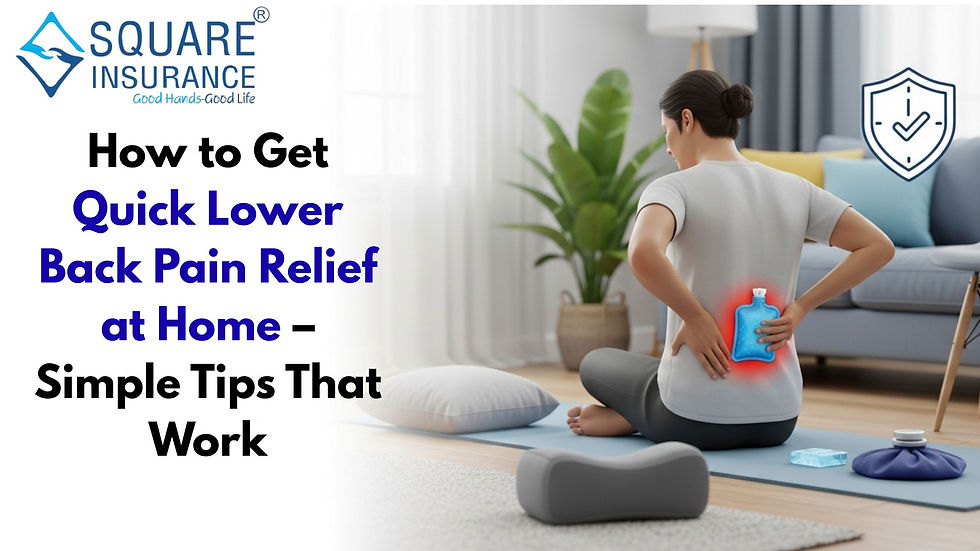How to Get Quick Lower Back Pain Relief at Home – Simple Tips That Work
- Square Insurance Brokers

- Aug 4
- 4 min read

One of the most prevalent issues affecting people of all ages is lower back pain. Whether it is due to sitting for long hours, lifting heavy items incorrectly, or bad posture, it can cause discomfort and affect daily activities. The good news is that most cases of lower back pain can be treated at home with simple methods.
In this blog, we’ll guide you on how to get quick lower back pain relief at home using easy and effective techniques. We’ll also discuss the possible causes of pain, when to see a doctor, and how to prevent it from coming back.
Common Causes of Lower Back Pain
Before we talk about relief methods, it’s important to understand what may be causing your lower back pain. Some of the common causes include:
Poor sitting posture
Prolonged sitting or standing
Muscle strain or sprain
Lack of physical activity
Lifting heavy objects improperly
Weak core muscles
Sleeping on an unsupportive mattress
Stress and tension
Knowing the cause of your pain can help you take the right steps for quick relief.
How to Get Quick Lower Back Pain Relief at Home
Here are some simple home remedies and techniques that can help you reduce lower back pain quickly:
1. Cold and Hot Compress
One of the easiest ways to get quick relief is by using cold and hot compresses.
Cold Compress: Apply an ice pack or cold cloth on the affected area for the first 24–48 hours. It helps reduce swelling and numbs the sore tissues.
Hot Compress: To ease tense muscles and increase blood flow, apply a heating pad or warm towel after the first 48 hours.
Use compresses for 15-20 minutes at a time, 2–3 times a day.
2. Stretching Exercises
Simple lower back stretches can reduce pain and improve flexibility. Here are a few effective stretches:
Child’s Pose: Bend forward, sit back on your heels, and kneel on the ground. Hold for 20–30 seconds.
Knee-to-Chest Stretch: Pull one knee toward your chest while lying on your back to perform the knee-to-chest stretch.
Cat-Cow Stretch: Get on your hands and knees, alternate between arching your back and lowering it.
Repeat these exercises gently 2–3 times a day for the best results.
3. Maintain Good Posture
Bad posture puts extra pressure on your lower back. Make sure to:
Sit up straight with your back supported
Keep your feet flat on the floor
Avoid slouching or leaning forward for long periods
Use a chair with back support if you work at a desk
A small change in posture can bring big relief.
4. Over-the-Counter Pain Relief
If the pain is severe, you can take over-the-counter pain relievers like:
Paracetamol
Ibuprofen
Muscle relaxants (as prescribed)
Do not take painkillers for more than a few days without medical advice. Never deviate from the label's suggested dosage.
5. Gentle Movement & Walking
While bed rest may seem like a good idea, too much rest can make your back stiffer. Try to stay lightly active.
Take short walks inside your home
Do light household chores
Avoid heavy lifting or sudden movements
Gentle movement increases circulation and helps heal sore muscles.
6. Correct Sleeping Position
Your sleeping posture plays an important role in managing back pain. Here’s how to improve it:
Sleep on your side with a pillow between your knees
Use a firm mattress that supports your spine
Avoid sleeping on your stomach
A proper sleeping posture allows your back muscles to relax fully.
7. Use a Lumbar Support Cushion
If you spend long hours sitting at work or while driving, using a lumbar support cushion can help. It supports the natural curve of your lower spine and reduces pressure on the back.
You can also roll up a towel and place it behind your lower back while sitting.
8. Stay Hydrated and Eat a Healthy Diet
Surprisingly, dehydration can lead to stiff muscles and joint pain. Drink enough water throughout the day and eat foods rich in:
Omega-3 fatty acids (found in fish, flaxseeds)
Calcium and Vitamin D (found in dairy, eggs, sunlight)
Anti-inflammatory foods like turmeric, ginger, leafy greens
A healthy diet keeps your muscles strong and prevents further damage.
9. Practice Breathing and Relaxation Techniques
Stress can tighten your back muscles and make the pain worse. Try:
Deep breathing exercises
Meditation
Gentle yoga
Listening to calming music
Your body will relax and heal more quickly if you reduce stress.
When to See a Doctor
If your lower back pain does not improve within a few days, or if you experience the following symptoms, consult a doctor immediately:
Pain that radiates to your legs
Numbness or tingling in the legs or feet
Weakness in the legs
Difficulty in walking or standing
Pain after an accident or injury
Unexplained weight loss or fever
Don’t ignore warning signs. Early diagnosis can prevent serious complications.
Tips to Prevent Lower Back Pain in Future
Once your pain is under control, follow these steps to avoid it in the future:
Exercise regularly to strengthen your back and core muscles
Avoid lifting heavy items, or lift using your knees, not your back
Maintain a healthy weight
Stretch before and after workouts
Don’t sit in one position for too long
Choose footwear that supports your posture
Taking care of your back now can save you from chronic pain later.
Final Thoughts
Lower back pain can be frustrating, but you can manage it effectively at home using these simple tips. From cold and hot therapy to stretching and posture correction, knowing how to get quick lower back pain relief at home can help you recover faster and avoid future problems.
If your pain continues or becomes worse, don’t hesitate to speak with a healthcare professional. Early treatment leads to better recovery.
For more helpful health and wellness tips, stay connected with our blog athttps://www.squareinsurance.in/blog/health-insurance-news/how-to-get-quick-lower-back-pain-relief-at-home









Comments